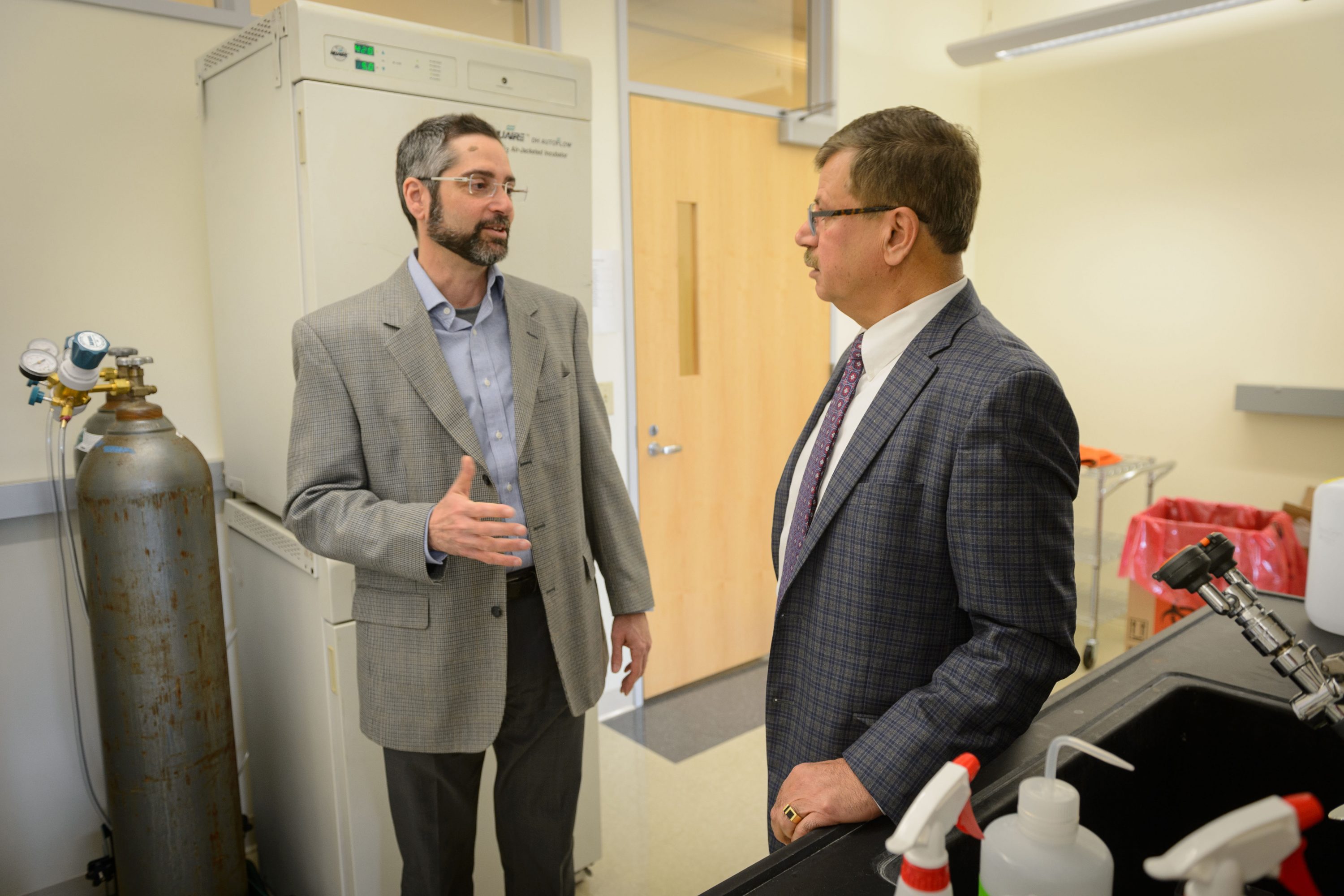The worldwide race to find ways to prevent, treat, manage, or test for COVID-19 infection includes several Connecticut biotech companies.

Five of them took part in a recent virtual panel discussion organized by BioCT, an advocacy group for Connecticut’s bioscience cluster, and moderated by Mostafa Analoui from UConn’s Office of the Vice President for Research and Technology Incubation Program (TIP).
From The Jackson Laboratory for Genomic Medicine on the UConn Health campus in Farmington, where COVID-19 diagnostic testing of Connecticut samples has been taking place for a month, Mark Adams, professor and director of microbial genomic services, says many questions still surround the matter of testing – particularly in the area of serology, or the analysis of blood for immune response.
“The models that I’ve seen – and if the country is beginning to get a handle on flattening the curve and limiting the number of transmissions this summer – really 95% of Americans are not going to have contracted coronavirus this spring,” Adams says. “And so the serology alone, I think, is not going to be a solution for bringing people back to work and certifying a large portion of the population as safe, assuming that the presence of antibodies means that someone can’t be infected again. So I think there’s a multifactorial approach that’s going to be needed that will involve some combination of large testing centers, specialized testing centers, point-of-care devices, and if at-home testing comes online, there’ll be a role for that as well.”
“I think there’s a multifactorial approach that’s going to be needed that will involve some combination of large testing centers, specialized testing centers, point-of-care devices, and if at-home testing comes online, there’ll be a role for that as well.”
Mark Adams, The Jackson Laboratory for Genomic Medicine
At-home testing is the target of 4Catalyzer, a firm headquartered in Guilford that accelerates startups.
“We’re developing right now an at-home test, a full at-home test kit with which the users can collect their own specimen, perform the test themselves, and interpret the results themselves,” says engineer Eric Kabrams. “In parallel to that, we’re planning for success scaling up the manufacturing and supply chain lines and working as hard as we can to get this out there as quickly as possible.”
He says initially the at-home test would be simply a positive or negative, but eventually the goal is to enable quantitative testing.
Patrice Milos, president, CEO and founder of Medley Genomics in Providence, also weighed in on testing, noting that the emergence of rapid testing that promises same-day, even same-hour, results, still has limitations.
“That just addresses whether an individual has the virus at the time of infection, versus the serology that everybody is interested in to understand all these asymptomatic individuals, which there are many it appears,” Milos says. “We could then identify those as having had the viral infection and looking for IgG and IgM antibodies, to say these people have been exposed, they’ve elicited immune response, and potentially offer a way to bring people back to work, introduce them back into their workplaces.”
Antibodies are blood proteins involved in our response to infection. The ones known as IgM appear shortly after infection. As the infection clears, they give way to IgG antibodies, which provide long-term protection.
What’s not universally known yet, Milos says, is how good the tests are, if they’re sensitive enough, if they’re specific enough, and how prone they may be to false positives or false negatives.
At Thetis Pharmaceuticals, a UConn TIP company headquartered in Branford, scientists already had been working on what they’re calling “TP-317,” a treatment for acute respiratory distress syndrome, or ARDS, “which is the principle cause of mortality in COVID-19 patients, characterized in particular by patients who develop pneumonia and then progress to ventilation,” says founder and CEO Gary Mathias. “We’re undertaking a development program to get 317 into the clinic we hope by Q3 of this year.”
“While the press is talking about the fact that we will have a surge of hospitalizations and in deaths in the near term, it is expected that there will be a rebound of COVID-19 in the fall or winter, before a vaccine is likely to be developed.”
Gary Mathias, Thetis Pharmaceuticals
Mathias says ARDS affects almost 250,000 people a year in the U.S. and has no approved therapies, making it a critical unmet medical need that already existed; the pandemic only compounds it, both today and in the future.
“While the press is talking about the fact that we will have a surge of hospitalizations and in deaths in the near term, it is expected that there will be a rebound of COVID-19 in the fall or winter, before a vaccine is likely to be developed,” Mathias says. “Therefore the urgency around treating acute respiratory distress syndrome will continue.”
A vaccine may be on the fast track at CaroGen Corporation, a UConn TIP company located in the Cell and Genome Sciences Building in Farmington. Scientists there have been working on an artificial virus that can deliver multiple antigens.
“Because it’s artificially made, the components of this virus come from different viruses that do not commonly infect humans, so there is no preexisting immunity for the patients or volunteers who receive it,” says President and CEO Bijan Almassian. “There are a number of advantages of this VLV (virus-like vesicle) over the existing platform. One, its ability to deliver multiple antigens. So there are a number of antigens in COVID-19, of course, the major one is S. There’s another antigen, it’s called N, or nuclear protein. And the other advantage of this platform is self-adjuvanting. There is no need for adding adjuvant to it. So the platform has broad application in infectious diseases. It could be used as prophylactic because you can use antibody against the antigens and also you can basically induce T cells against the antigens of interest.”
A COVID-19 predecessor had the attention of NanoViricides in Shelton, which in 2014 was working on molecular modeling for the Middle Eastern Respiratory Syndrome Coronavirus. NanoViricides’ approach involves a specific cell protein identified as an entry point for COVID-19.
“We found a few structures that actually would bind exactly in the space where the S protein of the virus binds to the ACE2 receptor,” says Executive Chairman and President Anil Diwan. “That’s very important for us because that means that we will be not only attacking the virus particle, but also ensuring that when the virus changes genomically, through mutations or other exchanges, it still continues to bind to the same receptor the same way, so our drug would still continue to be effective. And that’s very important virology because viruses mutate away and escape drugs regularly.”
The idea is to trick the virus into binding to the drug rather than to human cells.
“This is a completely novel drug,” Diwan says, adding that he’s hopeful to get human trials started in six to eight weeks.



